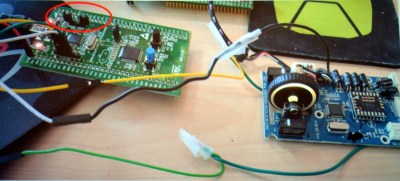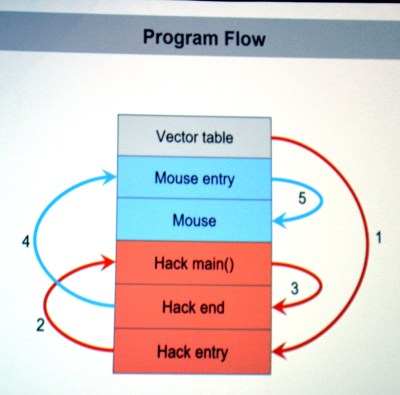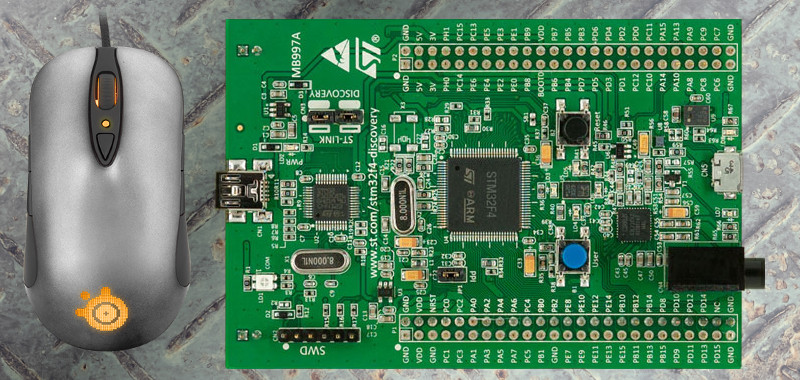Here’s a DEF CON talk that uses tools you likely have and it should be your next hacking adventure. In their Saturday morning talk [Mark Williams] and [Rob Stanely] walked through the process of adding their own custom code to a gaming mouse. The process is a crash course in altering a stock firmware binary while still retaining the original functionality.
The jumping off point for their work is the esports industry. The scope of esporting events has blown up in recent years. The International 2016 tournament drew 17,000 attendees with 5 million watching online. The prize pool of $20 million ($19 million of that crowdfunded through in-game purchases) is a big incentive to gain a competitive edge to win. Contestants are allowed to bring their own peripherals which begs the questions: can you alter a stock gaming mouse to do interesting things?
 The steelseries Sensei mouse was selected for the hack because it has an overpowered mircocontroller: the STM32F103CB. With 128 KB of flash the researchers guessed there would be enough extra room for them to add code. STM32 chips are programmed over ST-Link, which is available very inexpensively through the ST Discovery boards. They chose the STM32F4DISCOVERY which runs around $20.
The steelseries Sensei mouse was selected for the hack because it has an overpowered mircocontroller: the STM32F103CB. With 128 KB of flash the researchers guessed there would be enough extra room for them to add code. STM32 chips are programmed over ST-Link, which is available very inexpensively through the ST Discovery boards. They chose the STM32F4DISCOVERY which runs around $20.
Perhaps the biggest leap in this project is that the firmware wasn’t read-protected. Once the data, clock, and ground pads on the underside of the board were connected to the Discovery board the firmware was easy to dump and the real fun began.
 They first looked through the binary for a large block of zero values signifying unused space in flash. The injected firmware is designed to enumerate as a USB keyboard, open Notepad, then type out, save, and execute a PowerShell script before throwing back to the stock firmware (ensuring the mouse would still function as a mouse). Basically, this builds a USB Rubber Ducky into stock mouse firmware.
They first looked through the binary for a large block of zero values signifying unused space in flash. The injected firmware is designed to enumerate as a USB keyboard, open Notepad, then type out, save, and execute a PowerShell script before throwing back to the stock firmware (ensuring the mouse would still function as a mouse). Basically, this builds a USB Rubber Ducky into stock mouse firmware.
There are a few useful skills that make taking on this project a worthwhile learning experience. To compile your custom code correctly you need to choose the correct offset address for where it will end up once pasted into the firmware binary. The vector table of the original code must be rewritten to jump to the injected code first, and it will need to jump back to the mouse execution once it has run. The program flow on the left shows this. Both of these jumps require the program counter and registers to be saved and restored. The ARM stack is subtractive and the address will need to be updated to work with the added code.
The talk ended with a live demo that worked like a charm. You can check out the code in the MDHomeBrew repo. In this case the PowerShell script adds keyboard shortcuts for DOOM cheats. But like we said before, the experience of getting under the hood with the firmware binary is where the value will be for most people. With this success under your belt you can take on more difficult challenges like [Sprite_TM’s] gaming keyboard hack where the firmware couldn’t easily be dumped and an update binary was quite obsfucated.
















Yeah i was thinking an off-color joke, but I’ll stick with this as a possible man-in-the-middle vector.
Shouldn’t that be mouse-in-the-middle?
Almost no cheap consumer devices lock down the memory. I turned a thermostat I found in the trash at my dad’s office into an arduino once.
You’re confusing write protection with read protection. It’s almost always possible to just wipe the chip and put your own code on it, but it’s a lot harder if you want to reuse the existing firmware – you have to get a copy of it first. Almost no product gets released without read protection enabled.
Your response is so much more eloquent than mine. Wish I would have hit refresh before submitting mine.
How exactly does the read protection work? How does the flash memory know if it is being read by an authorized entity (i.e. the peripheral’s processor) vs by an unauthorized entity (i.e. a ‘hacker’ using some flash reading tool)?
In my Kinect V2 I have some Winbond W25Q64FV:
3V 64M-BIT
SERIAL FLASH MEMORY WITH
DUAL/QUAD SPI & QPI
I have its datasheet, and was hoping I would be able to extract the contents when I find the time/priority, but from what you say I fear this would be impossible?
I fail to understand how the flash memory device knows if whatever circuit it is connected in is authorized or not?
The read protection applies to the flash memory INSIDE the microcontroller chip.
In your case, separate flash chips, there’s no read protection, but there could be encryption.
Okay I can understand your confusion, “locking down the memory” does not prevent you from over writing it, it prevents you from reading it. They “lock down the memory” to prevent people in china from making clones. They don’t give a fuck if you turn a thermostat into an arduino.
I once watched a colleague rip apart a supposedly high security card reader that was read-protected. Ingenious solution, but the short version is that there are other behaviours that you can co-opt into helping you with exfiltration. One keyword would be “stack”. That’s easier than dissolving chip casings and using microscopes and nanowire probes :)
I don’t have one to try it, haven’t owned a mouse since 1998, been all laptops since.
If you want to examine the firmware, you can download unencrypted firmware updates right from the support pages of many peripheral manufacturer.
This would be a boon to recoil hackers.
The real question is why your mouse needs an ARM chip and 128kb flash to begin with.
Removing input lag. That and manufacturer bragging rights.
It’s counterintuitive, but sometimes chips that are exactly what you need are more expensive than something vastly more powerful due to the more powerful chips being more widely used. Economy of scale is a hell of a thing.
Gives one more room to grow instead of coming up with something new every time there’s a product change.
Evaluating the sensor data does take a bit of doing, it doesn’t ‘magically’ get the position/movement you know.
Plus people want ‘profiles’ now with gaming mice.
no, sensor evaluates all of this stuff in hardware and outputs processed delta of movement in X/Y axis. Microcontrollers job is just being a glorified serial-to-USB converter.
For a nice and exploring online greater than about three several hours today, but My spouse and i certainly not found any kind of exciting report such as yours. It really is quite value ample in my situation. In my view, if perhaps just about all web owners plus people produced superb material because you possibly have, the internet may be considerably more beneficial than in the past.. svenska casino utan licens
Is there a link to the talk?
Nice code! i wonder if a aimbot could be added to the mouse so it could run scripts in fps games!
just to add i made an arduino leonardo aimbot that uses color detection in aimlab